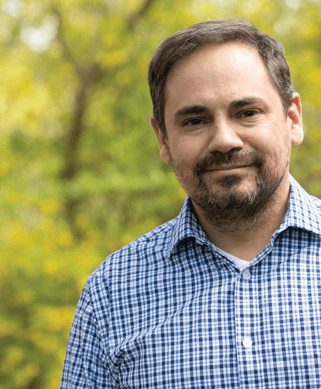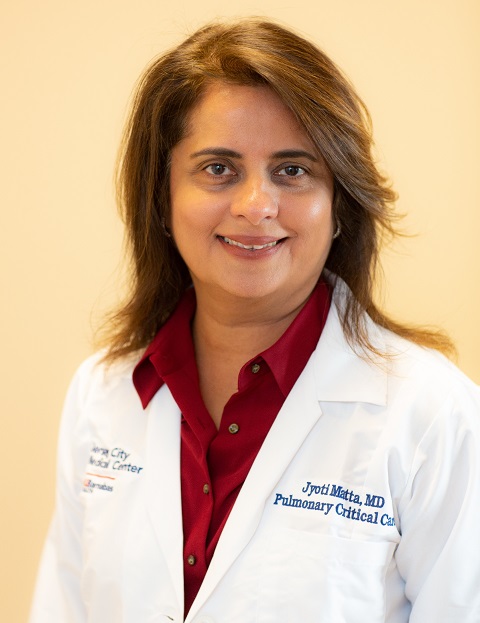“I pretty much slept through the whole night, with some tossing and turning. The whole process was very smooth.”

Jesse Gennarelli, 45, was intimately acquainted with fatigue. For 15 years, the special education teacher from Oradell rarely experienced a day when he didn’t feel tired. And though the fatigue didn’t affect his performance on the job, it did make everyday challenges a little more challenging.
At first, he wondered if the constant low-level weariness could be a side effect of the medication he was taking for anxiety, so he gradually cut back on the dosage. When a colleague told him about the Center for Sleep Disorders at Jersey City Medical Center, Jesse decided it was time to deal with the problem head-on. “Enough,” he says, “was enough.”

The first step was a telemedicine consultation with Jyoti Matta, MD, Medical Director of the Center for Sleep Disorders and a member of RWJBarnabas Health Medical Group. During the consultation, in which Dr. Matta took a complete sleep history, Jesse told her that he was often on his computer or phone late into the night and that his wife had mentioned that he sometimes snored. Dr. Matta recommended that Jesse participate in a sleep study at the center.
Overnight Assessment
During a sleep study, the patient’s oxygen levels, heart rate, depth of sleep, movements and possible snoring are monitored overnight using a variety of sensors attached to the skin. Jesse arrived at the center at 9 p.m. and was taken to one of its testing suites— private spaces more akin to luxury hotel accommodations than hospital rooms. There, a technician described in detail everything that was going to happen and placed the sensors. Then, Jesse slept.
“I pretty much slept through the whole night, with some tossing and turning,” he recalls. “The whole process was very smooth.”
Once the results were analyzed, he had another telemedicine appointment with Dr. Matta. She advised him that, while being on computer and phone screens before bed could be interfering with his sleep, the study indicated that the root cause of his fatigue could be a mild case of obstructive sleep apnea (OSA), a condition in which the muscles at the back of the throat relax too much and therefore interfere with breathing.
Patients with OSA are often awakened multiple times throughout the night when their airways are partially or fully blocked, resulting in daytime sleepiness. “OSA is incredibly common,” says Dr. Matta. “It’s more common in men—four out of 10 men are likely to suffer from it—although women catch up in the postmenopausal age group.” People most at risk are those who snore, those of Asian, Southeast Asian and Filipino descent, African American men, people carrying excess weight, smokers, football players and bodybuilders with highly muscular necks. Of those risk factors, Jesse only had two: snoring and being male.
In addition to causing fatigue, OSA can also have more serious consequences, including weight gain and cardiac issues like stroke, hypertension, atrial arrhythmias, heart attacks and heart failure. The good news: It’s relatively easy to treat, usually by a technique known as continuous positive airway pressure, or CPAP, which Dr. Matta calls “the gold standard of apnea treatment.”
A Flow of Air
With this treatment, the patient is fitted with a mask that delivers a constant flow of air through a slender hose, which keeps the patient’s airway open as he sleeps. The mask is attached to a machine about the size of a clock radio.
Jesse received his CPAP machine not long after his second consultation with Dr. Matta, who was hopeful that a monthlong trial would determine its efficacy in alleviating his fatigue. It took him a few days to get used to the machine, but, like many, if not most, CPAP users, he acclimated well to it.
In fact, Dr. Matta notes, the more patients have struggled with sleep apnea, the more they’re likely to adjust to CPAP. “Once they experience high-quality sleep using the CPAP, they’re in love with it,” she explains.
To ensure a positive CPAP experience, the Center for Sleep Disorders offers clinics led by registered technicians to help patients adjust to the machine. “PAP naps”—short naps in which patients are monitored as they wear the CPAP equipment to pinpoint problems and offer solutions—are another tool to help patients adjust.
Those who can’t adapt to CPAP can try one of several alternatives, including Provent, a mesh placed around the nostrils, and Inspire, a small device implanted in the body, both of which work by keeping the airway open.
It’s still too early to determine whether CPAP will fully quell Jesse’s fatigue, in part because of the newborn daughter who’s been depriving him of sleep at least as effectively as his sleep apnea did. But he notes that, when his wife took both of his daughters for an overnight with their grandmother, he slept through the night with no interruptions. “I don’t think I moved an inch,” he says. “I was very encouraged by that.” He’s hopeful that when the baby starts sleeping through the night and waking up rested, so will he.
The Center for Sleep Disorders treats a wide range of conditions, including insomnia, narcolepsy, restless leg syndrome, sleepwalking and more. To learn more, call 201-915-2020.